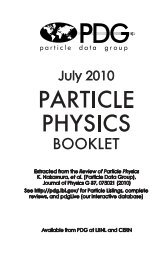30. Passage of particles through matter 1 - Particle Data Group
30. Passage of particles through matter 1 - Particle Data Group
30. Passage of particles through matter 1 - Particle Data Group
You also want an ePaper? Increase the reach of your titles
YUMPU automatically turns print PDFs into web optimized ePapers that Google loves.
<strong>30.</strong> <strong>Passage</strong> <strong>of</strong> <strong>particles</strong> <strong>through</strong> <strong>matter</strong> 25<br />
Figure <strong>30.</strong>17: Probability P that a photon interaction will result in<br />
conversion to an e + e − pair. Except for a few-percent contribution from<br />
photonuclear absorption around 10 or 20 MeV, essentially all other<br />
interactions in this energy range result in Compton scattering <strong>of</strong>f an atomic<br />
electron. For a photon attenuation length λ (Fig. <strong>30.</strong>16), the probability<br />
that a given photon will produce an electron pair (without first Compton<br />
scattering) in thickness t <strong>of</strong> absorber is P[1 − exp(−t/λ)].<br />
(X 0 N A /A) dσ LPM /dx<br />
1.00<br />
0.75<br />
0.50<br />
0.25<br />
1 TeV<br />
10 TeV<br />
100 TeV<br />
Pair production<br />
1 EeV<br />
100 PeV<br />
1 PeV<br />
10 PeV<br />
0<br />
0 0.25 0.5<br />
x = E/k<br />
0.75 1<br />
Figure <strong>30.</strong>18: The normalized pair production cross section dσLPM/dy,<br />
versus fractional electron energy x = E/k.<br />
June 18, 2012 16:19







